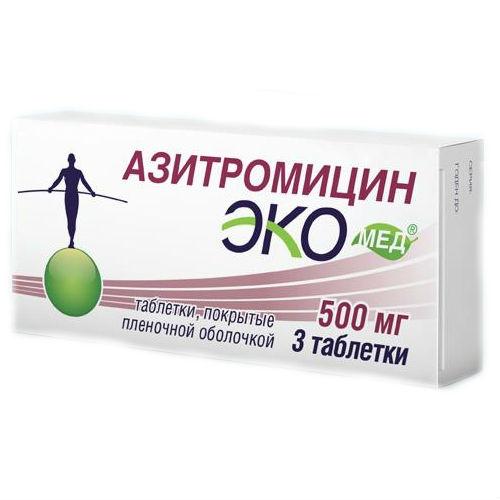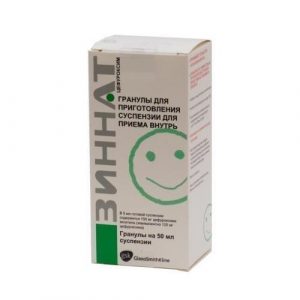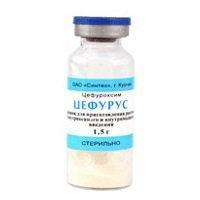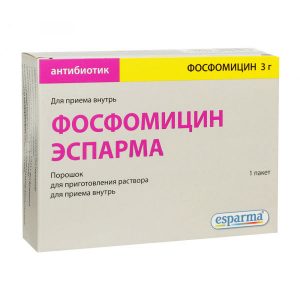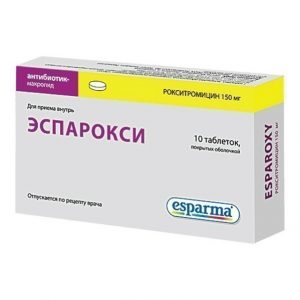Description
Latin name
Azithromycin Ecomed
Release form
Yellow film-coated tablets, capsule-shaped, biconvex. Two layers are visible in the cross section. The inner layer is white or almost white.
Packing
In a pack of 3 tablets.
Pharmacological action
Broad-spectrum antibacterial drug from the group of azrolide macrolides, has a bacteriostatic effect. By binding to the 50S subunit of ribosomes, it inhibits the peptide translocase at the translation stage, inhibits protein synthesis, slows the growth and reproduction of bacteria, and has a bactericidal effect in high concentrations. It acts on extra- and intracellularly located pathogens.
Microorganisms may be initially resistant to the action of the antibiotic or may become resistant to it.
Indications
Infectious and inflammatory diseases caused by microorganisms sensitive to azithromycin:
infections of the upper respiratory tract and ENT organs: pharyngitis, tonsillitis, sinusitis, otitis media
infections of the lower respiratory tract: acute bronchitis, bronchitis, exacerbation, exacerbation .h. caused by atypical pathogens of
skin and soft tissue infections: common acne of moderate severity, erysipelas, impetigo, secondarily infected dermatoses
initial stage of Lyme disease (borreliosis) – migratory erythema (erythema migrans)
of urinary tract infections, caused by Chomatis trachomatis, )
Contraindications
hypersensitivity to antibiotics of the
macrolide group severe hepatic and / or renal failure
children under 12 years of age with a body weight of less than 45 kg (for this dosage form)
breastfeeding with srdlkgergom and taking.
Caution:
moderate dysfunction of the liver and kidneys
with arrhythmias or a predisposition to arrhythmias and lengthening of the QT interval
with the combined use of terfenadine, warfarin, digoxin
simultaneous administration with ergotamine and dihydroergotamine.
Use during pregnancy and lactation
Azithromycin during pregnancy is recommended only in cases where the expected benefits of taking it for the mother outweighs the potential risk to the fetus.
During treatment with azithromycin, breastfeeding is stopped.
Composition
One tablet contains:
Active ingredient: azithromycin dihydrate in terms of azithromycin 250 mg
Excipients: lactulose 300 mg, calcium phosphate dihydrate 59.8 mg, corn starch 24.0 mg, hypromellose 5 lauryl sulfate 1.2 mg, croscarmellose sodium 20.0 mg, magnesium stearate 6.0 mg, microcrystalline cellulose to obtain a tablet without a shell weighing 700 mg
Excipients: hypromellose 9.49 mg, titanium dioxide 5.2 mg, macrogol- 4000 4.16 mg, talc 1.12 mg, dye tropeolin-O 0.03 mg, d obtaining coated tablets weighing 720 mg.
Dosage and administration
Ecomed ® is taken orally, without chewing, 1 time per day, regardless of food intake.
Adults (including older people) and children over 12 years old with body weight over 45 kg.
For infections of the upper and lower respiratory tract, ENT organs, skin and soft tissues: 0.5 g per day for 3 days (course dose – 1.5 g).
For acne vulgaris of moderate severity: 0.5 g per day for 3 days, then 0.5 g once a week for 9 weeks. The first weekly pill should be taken 7 days after taking the first daily pill (8th day from the start of treatment), the next 8 weekly tablets with an interval of 7 days. Course dose 6.0 g.
With erythema migrans: 1 time per day for 5 days, 1st day 1.0 g. Then from 2nd to 5th day, 0.5 g. Course dose 3, 0 g.
For urinary tract infections caused by Chlamydia trachomatis (urethritis, cervicitis): 1.0 g once.
Prescribing to patients with impaired renal function.
For patients with moderate impaired renal function (creatinine clearance> 40 ml / min), dose adjustment is not necessary.
Side effects of the
Digestive system: nausea, vomiting, diarrhea, abdominal pain, loose stools, flatulence, digestive upset, anorexia, constipation, discoloration of the tongue, pseudomembranous colitis, cholestatic jaundice, hepatitis, changes in laboratory parameters liver failure, liver necrosis (possibly fatal).
Allergic reactions: itching, skin rashes, angioedema, urticaria, photosensitivity, anaphylactic reaction (in rare cases, fatal), erythema multiforme, Stevens-Johnson syndrome, toxic epidermal necrolysis.
From the cardiovascular system: palpitations, arrhythmia, ventricular tachycardia, increased QT interval, bidirectional ventricular tachycardia.
From the nervous system: dizziness / vertigo, headache, cramps, drowsiness, paresthesia, asthenia, insomnia, hyperactivity, aggressiveness, anxiety, nervousness.
From the sensory organs: tinnitus, reversible hearing loss up to deafness (when taking high doses for a long time), violation of the perception of taste and smell.
From the circulatory and lymphatic systems: thrombocytopenia, neutropenia, eosinophilia.
From the musculoskeletal system: arthralgia.
From the genitourinary system: interstitial nephritis, acute renal failure.
Other: vaginitis, candidiasis.
Drug Interaction
Antacids do not affect the bioavailability of azithromycin, but reduce the maximum blood concentration by 30%, so the drug should be taken at least one hour before or two hours after taking these drugs and meals.
In parenteral use, azithromycin does not affect the concentration of cimetidine, efavirenz, fluconazole, indinavir, midazolam, triazolam, co-trimoxazole in plasma when co-administered, however, the possibility of such interactions in the administration of azithromycin for ingestion should not be excluded.
When co-administered with cyclosporine, it is recommended that blood cyclosporine be monitored.
When digoxin and azithromycin are taken together, it is necessary to control the concentration of digoxin in the blood, because many macrolides increase the absorption of digoxin in the intestine, thereby increasing its concentration in blood plasma.
Careful monitoring of prothrombin time is recommended when co-administered with warfarin.
Concomitant administration of terfenadine and macrolide-class antibiotics causes arrhythmia and QT prolongation. Based on this, the above complications with the co-administration of terfenadine and azithromycin cannot be excluded.
Since there is a possibility of inhibiting the CYP3A4 isoenzyme with azithromycin in parenteral form when co-administered with cyclosporine, terfenadine, ergot alkaloids, cisapride, pimozide, quinidine, astemizole and other drugs, metabolism of which is caused by metabolism reception inside.
When co-administered with azithromycin and zidovudine, azithromycin does not affect the pharmacokinetic parameters of zidovudine in blood plasma or the renal excretion of its and its glucuronid metabolite. However, the concentration of the active metabolite – phosphorylated zidovudine in peripheral vascular mononuclear cells is increasing. The clinical significance of this fact is not clear.
Toxicity of macrolides with ergotamine and dihydroergotamine may be manifested by their toxic effect.
Overdose
Symptoms: temporary hearing loss, nausea, vomiting, diarrhea.
Treatment is symptomatic.
Storage conditions
In a dry, dark place at a temperature of no higher than 25 ° C.
Keep out of the reach of children.
Expiration
2 years. Do not use after the expiry date.
Deystvuyuschee substances
Azithromycin
Conditions of supply of pharmacies
Prescription
